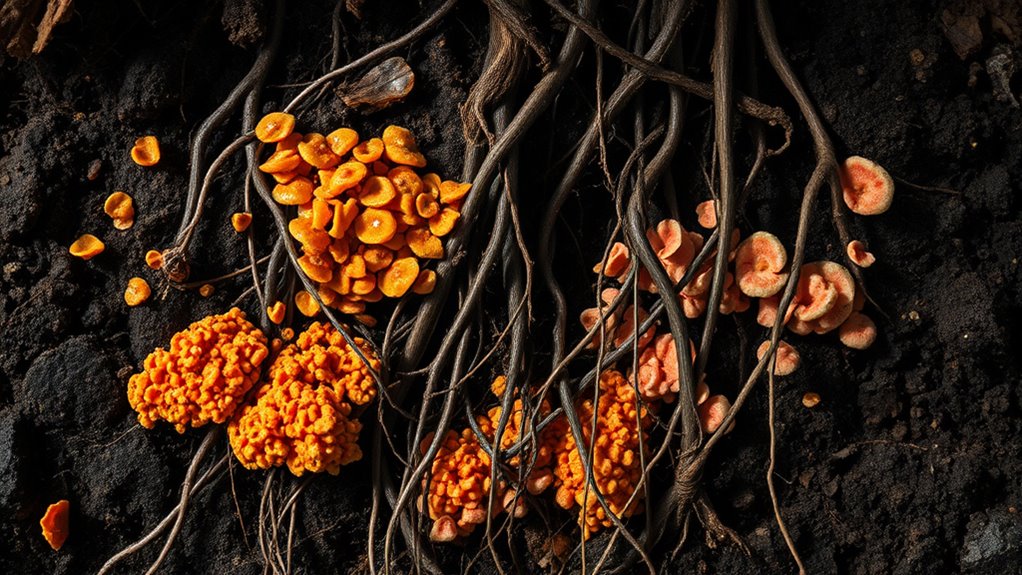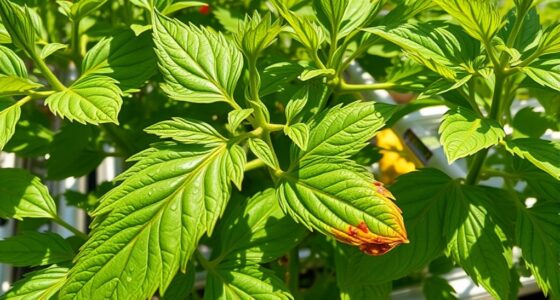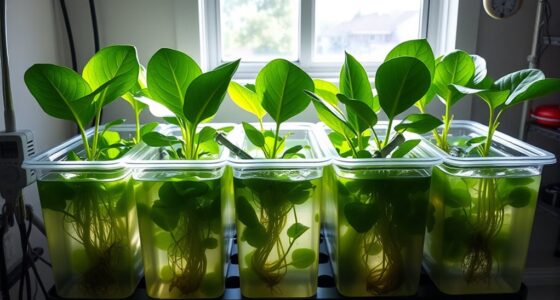To identify root zone pathogens like Pythium, Fusarium, and Rhizoctonia, observe your plants for symptoms such as wilting, yellowing leaves, and root rot. Pythium causes sudden wilting in wet, poorly drained soils, with rotted, slimy roots. Fusarium leads to yellowing and browning stems, especially in dry conditions. Rhizoctonia creates sunken wounds on roots and stems, often in warm, moist environments. Recognizing these signs helps you better manage issues; explore further to protect your plants effectively.
Key Takeaways
- Pythium causes sudden wilting in overly wet soils, with rotted, slimy, dark roots, and thrives in soggy conditions.
- Fusarium leads to persistent wilting and yellowing, with brown rotted roots, often in drier soils, blocking water flow inside plants.
- Rhizoctonia results in damping-off seedlings or sunken, dark root lesions in mature plants, especially in warm, moist environments.
- Regular root inspection for rot, discoloration, and lesions helps distinguish among these pathogens.
- Improving drainage, crop rotation, and targeted treatments are essential for managing root zone diseases effectively.

Root zone pathogens are microorganisms that infect the soil area surrounding plant roots, causing diseases that can weaken or kill plants. When these pathogens invade, they disrupt the plant’s ability to absorb water and nutrients, leading to symptoms like wilting, stunted growth, yellowing leaves, and in severe cases, plant death. Recognizing these pathogens early is vital for effective management and preserving plant health.
Root zone pathogens weaken plants by infecting roots, causing wilting, yellowing, and potential death.
One of the most common root zone pathogens is Pythium, often called water mold. You might notice Pythium infections in overly wet soils or poorly drained areas. Plants infected with Pythium typically exhibit sudden wilting, especially during warm, moist conditions. The roots may appear rotted, slimy, and discolored—often brown or black—making it clear that the pathogen has compromised the root system. Since Pythium thrives in soggy soils, improving drainage and avoiding overwatering are your best defenses. Fungicides labeled for Pythium can help, but they work best when combined with cultural practices that reduce soil moisture.
Fusarium is another major player in the root pathogen world. Unlike Pythium, Fusarium often infects plants in drier conditions and can persist in the soil for years through resting spores. You’ll recognize Fusarium-infected plants by yellowing or wilting leaves that don’t recover even after watering, along with a characteristic browning or rotting of the roots and lower stem. Fusarium can cause vascular wilt, which blocks water movement within the plant, leading to rapid decline. To combat Fusarium, focus on crop rotation, resistant varieties, and soil health. Chemical treatments can help, but prevention through cultural practices often proves more effective.
Then there’s Rhizoctonia, which causes root rot and damping-off in seedlings. You might see seedlings suddenly collapse or fail to emerge altogether. In mature plants, Rhizoctonia creates sunken, dark lesions on roots and stems. It tends to attack when environmental conditions are warm and moist, and its presence is often indicated by a greasy, moldy appearance on affected roots. Managing Rhizoctonia involves good sanitation, avoiding overly dense planting, and ensuring proper watering practices to prevent soil from staying too wet. Additionally, understanding the life cycle of these pathogens can help in designing effective crop rotation and soil management strategies.
Understanding these pathogens means paying attention to your plant’s environment and health. Regularly inspect roots and lower stems for signs of rot or discoloration. Maintaining proper drainage, avoiding overwatering, and practicing crop rotation greatly reduce your risk. If you suspect infection, acting quickly with targeted treatments and cultural adjustments can save your plants. Recognizing the distinct signs of Pythium, Fusarium, and Rhizoctonia enables you to implement effective strategies and keep your plants thriving despite these invisible threats.
Frequently Asked Questions
How Can I Prevent Root Zone Pathogens in My Garden?
To prevent root zone pathogens, you should improve soil drainage and avoid overwatering your garden. Use sterile or well-composted soil, rotate crops regularly, and remove infected plants promptly. Incorporate organic matter to boost soil health and promote beneficial microbes. Avoid working in wet soil, and sanitize tools between uses. These steps create a healthier environment, reducing pathogen buildup and protecting your plants from root infections.
Are Organic Methods Effective Against Root Zone Pathogens?
Sure, organic methods are surprisingly effective against root zone pathogens, even if it seems too good to be true. You can boost your soil’s resilience by adding organic compost, practicing crop rotation, and using organic fungicides like neem oil. These natural strategies often outsmart the pathogens, making your garden healthier without synthetic chemicals. So, yes, embracing organic practices can be your best defense, proving nature’s power in plant protection.
What Are the Early Signs of Root Zone Infections?
You’ll notice root zone infections early on through symptoms like wilting, yellowing leaves, and stunted growth. The plant may appear stressed despite adequate watering, and roots might look discolored, mushy, or rotten. You might also see an unpleasant odor near the roots. Catching these signs early allows you to act quickly, reducing damage and preventing the spread of pathogens in your plants.
Can Crop Rotation Eliminate Root Zone Pathogens?
Crop rotation can substantially reduce root zone pathogens, but it might not eliminate them entirely. By changing crops, you disrupt the life cycle of specific pathogens, limiting their build-up in the soil. However, some pathogens can survive in soil for years, so combining rotation with other practices like soil solarization, proper drainage, and resistant varieties offers a more thorough approach to managing root zone diseases effectively.
How Do Environmental Conditions Influence Pathogen Development?
Environmental conditions play a vital role in pathogen development. If you keep the soil moist and warm, pathogens like Pythium and Fusarium thrive, spreading rapidly. Conversely, dry, well-ventilated conditions slow their growth. You should monitor temperature and moisture levels closely, adjusting irrigation and drainage accordingly. By managing these factors, you can greatly reduce pathogen proliferation and protect your crops from root zone diseases.
Conclusion
Now you know the culprits lurking in your root zone—Pythium, Fusarium, and their friends. By understanding these pathogens, you can act before they take hold, much like catching a small leak before it floods your entire garden. Stay vigilant, practice good hygiene, and choose resistant varieties. Remember, your plants’ health is the foundation of a thriving garden. With knowledge and care, you’ll turn the tide and keep your roots strong and happy.










